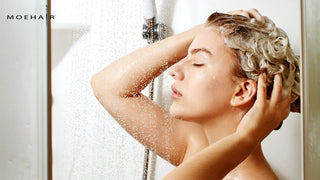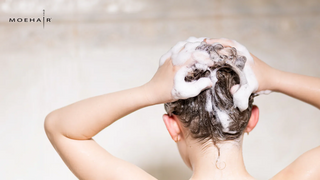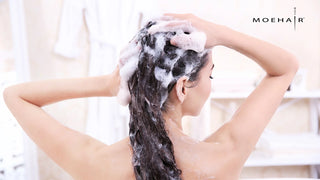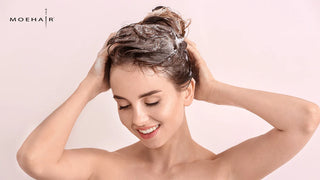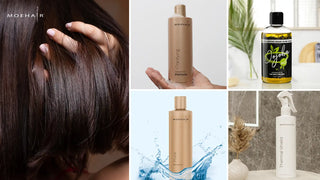 Table of contents
Table of contents
In the world of hair care, especially when color-treated hair is involved, choosing the right shampoo is crucial. Whether you’ve colored your strands in bold hues or some subtle highlights, maintaining the health and vibrancy of your tresses requires special care.
Color-treated hair is, by its very nature, more fragile than untreated hair. The process of coloring requires a combination of chemicals that alter the mane’s structure to allow pigments to penetrate. This can lead to various challenges, such as dryness, breakage, and fading. The right shampoo, however, can protect the integrity of your strands, prolong their shine, and reduce the risks of damage.
Understanding the difference
Color-safe shampoo, like Moehair Color Alive Shampoo, is specifically formulated to cleanse hair without stripping away color or causing further damage. It contains gentle cleansing agents that protect hues from fading and other ingredients that moisturize and strengthen hair. The shampoo is free of certain alcohols and chemicals that might otherwise weaken or strip color. It does not contain sulfates, a type of surfactant found in most regular shampoos. FYI, sulfates are effective cleansers but can be too harsh for colored tresses.
Regular shampoo is designed for general cleansing and maintenance. It contains ingredients that remove dirt, oil, and product buildup, but it may not always consider the needs of colored or chemically processed hair. While many regular shampoos contain sulfates to create a rich lather, Moehair Protein Infused Shampoo uses a sulfate-free lathering mechanism. This helps achieve flawless hair without compromising its vitality and makes the shampoo suitable for all hair types.
Here’s a breakdown of the differences between color-safe shampoo and regular shampoo:
| # | Color-safe shampoo | Regular shampoo |
|---|---|---|
| Ingredients | Formulated without sulfates, a color-safe shampoo excludes certain alcohols and artificial dyes. It usually contains mild surfactants, moisturizing agents, antioxidants, and UV protectants to prevent fading and keep color vibrant. | It may include stronger surfactants, like sulfates, to effectively remove oil and dirt. It may also contain artificial dyes, fragrances, and other additives that make hair feel cleaner and fresher after every wash. |
| Cleansing power | It offers gentle cleansing suitable for sensitive or chemically treated hair. This helps maintain the natural oils on the scalp and prevents the color from fading too quickly. | Known for its strong cleansing properties, it effectively removes dirt, dust, and oil but may strip color in the process. It can be a bit too rigorous on dyed strands, leading to faster fading. |
| Effect on color longevity | It helps prolong the life of your hair color. It is designed to ensure minimal color leaching, allowing you to go longer between touch-ups. | Since regular shampoo is not formulated to protect hues, it can result in quicker fading, especially for vibrant or pastel shades that require extra care. |
| Moisturizing properties | It is packed with natural oils, proteins, and emollients that restore moisture to counteract the drying effects of chemical treatments. | While many regular shampoos contain moisturizing agents, they may not be sufficient for processed hair, which has different hydration needs. Some regular shampoos may even contain alcohols that further dry out color-treated hair. |
| pH balance | Color-safe shampoo is pH-balanced to help maintain the hair’s natural acidic level. This is essential for closing the cuticle to lock in color molecules. | Not all regular shampoos are pH-balanced. Using a shampoo with an imbalanced pH can allow color molecules to escape more easily. |
Why should you use color-safe shampoo
If you've spent time and money on coloring your hair, using a color-safe shampoo helps ensure you get the most out of your treatment. Here’s how color-safe shampoo makes a difference:

Preserves color vibrancy and shine
Regular shampoos, especially those with sulfates, can quickly dull and fade color-treated hair. On the other hand, color-safe shampoos cleanse without stripping away color. This means you can flaunt your stunning hues for longer and extend the gap between salon appointments.
Protects against UV and environmental damage
Celebrity Hairstylist Sophie Gutterman says, “When you go in the sun, color-treated hair is more susceptible to damage. When you use hot tools like flat irons or curling irons, your hair could be damaged more.” Thus, color-protect shampoos shield against environmental aggressors that might degrade the appearance of the hues and texture of your tresses. They contain UV filters and heat-protecting agents that repair and rejuvenate the mane from deep within.
Reduces the need for frequent touch-ups
Color-safe shampoo reduces the frequency with which you need to touch up your hair color. This is not only cost-effective but also helps minimize damage, as frequent dyeing can weaken hair over time. Its formula is more moisturizing than regular shampoos, helping combat flyaways and frizz.
Choosing the best color-safe shampoo
Ahead, we’ve rounded up all the good characteristics of a color-safe shampoo that you must keep in mind.

- Sulfate-Free: Sulfates can cause color to fade, so opt for shampoos that are labeled "sulfate-free."
- UV Protection: If you’re frequently outdoors, consider a shampoo with UV filters to protect against sun-induced fading.
- Hydrating Ingredients: Look for shampoos that contain natural oils, humectants, and proteins to help keep hair hydrated.
- pH Balance: A balanced pH helps close the cuticle and lock in color, enhancing its longevity and shine.
- Antioxidants: Ingredients like vitamins C and E protect against environmental damage, extending the life of your color.
When to use regular shampoo
Regular shampoo can still be a part of your routine, even with color-treated hair. Here’s how:
- Clarifying Washes: Occasionally, buildup from styling products, oils, or even color-safe shampoos can weigh hair down. A deep cleansing shampoo can provide a deep cleanse but should be used mindfully, as it may also strip color.
- Non-Dyed Roots: If only parts of your hair are color-treated, you might apply a regular shampoo on the non-dyed sections, using a color-safe shampoo only on the treated parts.
- Pre-Treatment Preparation: Some hairstylists recommend using a regular shampoo before coloring hair to ensure it's free from any buildup, allowing color to absorb more evenly.
Experts answer frequently asked questions
Q1. How often should you wash color-treated hair?
To help preserve your color, limit washing to 2-3 times per week. Overwashing can cause color to fade faster, even with a color-protect shampoo.
Q2. Can you use regular shampoo on colored hair occasionally?
Yes, occasional use of regular shampoo won’t cause significant damage, but it may accelerate fading if used too frequently. If you must use regular shampoo, try to follow up with a conditioner or treatment formulated to help retain color.
Q3. Can you use color-safe shampoo on non-dyed hair?
Absolutely! Color-safe shampoos are gentle and hydrating, suitable for any hair type, especially if you have a sensitive scalp or dry hair.
Q4. Can you use color-safe shampoo with other treatments like keratin or relaxers?
Yes, color-safe shampoos are generally compatible with keratin or relaxer treatments, as they are curated to be gentler and free from sulfates. However, it’s still a good idea to consult with your stylist if you’re using multiple treatments on your hair.











